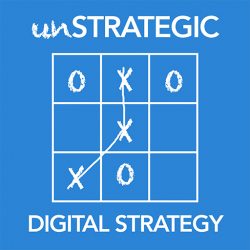As the new year begins and the unSTRATEGIC podcast is starting soon (coming out January 25th!), I want to take a moment to quickly talk about starting with strategy. If you’re new to the business of digital strategy and have questions like “what is strategy?” and “how do I start doing strategy?” then hopefully this post will bring some clarity to an ambiguous discipline.
Strategy, to me, is about making decisions. But for those of you who are just getting into it, it can be a bit confusing. Let’s define it in a few different ways.
Defining Strategy…
Strategy can be confusing because of its complexity. I see three different layers of strategy that can be defined.
- Strategy Disciplines: Disciplines come down to your area of expertise. This could be business strategy, brand strategy, web strategy, mobile strategy, and the list goes on. You could be a social media strategist or a content strategist. The different disciplines are the top layer.
- Strategy Processes: Diving a bit deeper, the second layer is the process we’ll use for strategy. I often use decision looping as my process in account management. But there are many different processes including waterfall, agile, scrum, adaptive path, critical path, etc.
- Strategy Tactics: This third layer is the one I think most people are concerned with. These are the tips, tricks, activities, and exercises that you can do on a project or engagement. One example is doing a competitive analysis. Mapping quantitative and qualitative data to see where you (or your client) stands against the competition. I’ll go into how I do a competitive analysis in one of my podcasts. But activities are the tactics you use to execute on strategy.
As we can see, there are a few different layers to strategy, which I refer to as the strategy object. You can go even further when you start talking about its relation to the entity, which is a business, brand, company, project, etc.
Taking the complexity out of strategy
If you want to get started on digital strategy, then decide on what area or discipline you like the most. Or what area or discipline this particular engagement requires. Are you setting up social media accounts for your clients? Are you building them a website? Social media strategy and web strategy respectively. But also business strategy because these things ultimately help your clients’ business (the entity).
Then decide on what process you’re going to follow. Look at all the data, this includes your client’s business, their users, their competitors, the marketplace, and influencers/best in business in their industry. There are ways to compile this information that I’ll touch on in my upcoming episodes. Interpret the data by looking for recurring themes or anomalies. Make a decision, take the action.
Within that loop is where you’ll be doing your strategy tactics. Discovery, documenting discovery, understanding their culture and business model. the list goes on.
Depending on the project I like to do a typical run through of tactics:
- Intake on client: business overview, history
- Goals, project mission, success metrics
- Systems, 3rd party technologies
- Content inventory
- Competitor analysis and social listening review
- Research the market; disruptor/influencer list of companies/technologies
- Google Analytics analysis
- Information architecture testing
- UX site review
There’s still a lot more to cover because the reality is that when it comes to digital projects or products, your job as a strategist is never really finished. You need to iterate on your process time and time again because of the shifting tides of the technology space. But that’s okay, we’ll cover all this and more in upcoming episodes. Stay tuned!!

